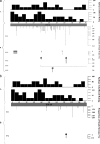DNA polymorphisms in the pepA and PPE18 genes among clinical strains of Mycobacterium tuberculosis: implications for vaccine efficacy
- PMID: 17893137
- PMCID: PMC2168324
- DOI: 10.1128/IAI.00335-07
DNA polymorphisms in the pepA and PPE18 genes among clinical strains of Mycobacterium tuberculosis: implications for vaccine efficacy
Abstract
Tuberculosis continues to be a leading cause of death worldwide. Development of an effective vaccine against Mycobacterium tuberculosis is necessary to reduce the global burden of this disease. Mtb72F, consisting of the protein products of the pepA and PPE18 genes, is the first subunit tuberculosis vaccine to undergo phase I clinical trials. To obtain insight into the ability of Mtb72F to induce an immune response capable of recognizing different strains of M. tuberculosis, we investigated the genomic diversity of the pepA and PPE18 genes among 225 clinical strains of M. tuberculosis from two different geographical locations, Arkansas and Turkey, representing a broad range of genotypes of M. tuberculosis. A combination of single nucleotide polymorphisms (SNPs) and insertion/deletions resulting in amino acid changes in the PPE18 protein occurred in 47 (20.9%) of the 225 study strains, whereas SNPs resulted in amino acid changes in the PepA protein in 14 (6.2%) of the 225 study strains. Of the 122 Arkansas study strains and the 103 Turkey study strains, 32 (26.2%) and 15 (14.6%), respectively, had at least one genetic change leading to an alteration of the amino acid sequence of the PPE18 protein, and many of the changes occurred in regions previously reported to be potential T-cell epitopes. Thus, immunity induced by Mtb72F may not recognize a proportion of M. tuberculosis clinical strains.
Figures

References
-
- Barnes, P. F., Z. Yang, S. Preston-Martin, J. M. Pogoda, B. E. Jones, M. Otaya, K. D. Eisenach, L. Knowles, S. Harvey, and M. D. Cave. 1997. Patterns of tuberculosis transmission in central Los Angeles. JAMA 278:1159-1163. - PubMed
-
- Behr, M. A., M. A. Wilson, W. P. Gill, H. Salamon, G. K. Schoolnik, S. Rane, and P. M. Small. 1999. Comparative genomics of BCG vaccines by whole-genome DNA microarray. Science 284:1520-1523. - PubMed
-
- Bifani, P. J., B. Mathema, N. E. Kurepina, and B. N. Kreiswirth. 2002. Global dissemination of the Mycobacterium tuberculosis W-Beijing family strains. Trends Microbiol. 10:45-52. - PubMed
-
- Bloom, B., and P. E. M. Fine. 1994. The BCG experience: implications for future vaccines against tuberculosis, p. 531-557. In B. Bloom (ed.), Tuberculosis: protection, pathogenesis, and control. ASM Press, Washington, DC.
-
- Brandt, L., Y. A. Skeiky, M. R. Alderson, Y. Lobet, W. Dalemans, O. C. Turner, R. J. Basaraba, A. A. Izzo, T. M. Lasco, P. L. Chapman, S. G. Reed, and I. M. Orme. 2004. The protective effect of the Mycobacterium bovis BCG vaccine is increased by coadministration with the Mycobacterium tuberculosis 72-kilodalton fusion polyprotein Mtb72F in M. tuberculosis-infected guinea pigs. Infect. Immun. 72:6622-6632. - PMC - PubMed
Publication types
MeSH terms
Substances
Grants and funding
LinkOut - more resources
Full Text Sources
Other Literature Sources
Miscellaneous

